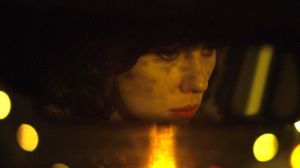They say cinematography is the art of painting with light. Until the last decade, that meant bulbs were your brushes, kilowatts your oils, celluloid your canvas. They were combined with care and purpose to elicit a certain mood. But with the advent of incredible low-light digital cameras, many filmmakers now opt to find the light rather than create it (rendering your job obsolete). Yet every once in a while, a film somehow manages to combine both techniques to stunning effect.
Rarely as stunning as Under the Skin.
Your own contributions from the lighting board seem fairly explicit. This aggressively art-house sci-fi picture features a number of scenes that take place in nondescript netherworlds or abstract interpretations of consciousness that all look like nightmarish Gap commercials. With full-black or full-white backgrounds, it's a classic studio set-up that's beautifully reverse-lit (the white background is accompanied by heavy shadows, the black background all high-key lighting that reveals every detail). There's also an incredibly gorgeous reflection off the floor, which becomes liquid whenever Scarlett Johansson - as some type of undefined alien - seduces random men. Breathtaking work, and the type of highly stylized treatment that writer/director Jonathan Glazer perfected in the 90s while creating big-budget TV commercials and iconic music videos of for bands like Radiohead, Jamiroquai, and Massive Attack.
However, the scenes where you appear to be absent are equally striking. Not so much when Johansson drives around Edinburgh, stopping men and assessing her prey--although the incognito cameras your fellow crew members created to film the real reactions of non-actors is impressive. Instead, I took notice of how far cinematographer Daniel Landin was willing to push the limits of his main Alexa camera in the more natural settings, shooting Johansson with almost no contrast, yet managing to extract key details on her face and body. It doesn't always create a flattering portrait, but it's mighty impressive from a technical standpoint. And extremely effective storytelling.
That said, you haven't made a "light" film in any sense of the word. Many of the images we get are uncomfortably disturbing. This film is all about what we see and feel, as opposed to what we're told. Exposition is non-existent; the story could probably fit on a cocktail napkin (it diverges greatly in form and purpose from Michel Faber's novel). The plot is often frustratingly obtuse, even simplistic. Depending on the level of engagement we're prepared to invest, it's either an arty version of Species _(with equal amounts of nudity), _or a provocative and challenging think-piece on genre politics. Repeated viewings should help shed some light on that.
Until then, rest easy knowing I liked what I saw.
Christopher







